生态启发的咪唑木质素离子液体对铁的缓蚀:一个综合的理论观点
IF 3.2
4区 化学
Q2 CHEMISTRY, MULTIDISCIPLINARY
引用次数: 0
摘要
开发对环境无害的铁缓蚀剂对工业效率和环境可持续性都至关重要。本文采用多尺度计算方法评价了三种木质素基离子液体对铁的缓蚀性能。通过整合密度泛函理论(DFT)、真实溶剂类导体筛选模型(cosmos - rs)、分子动力学(MD)和自一致电荷密度功能紧密结合(SCC-DFTB)模拟,对3-乙基-1-甲基- 1h -咪唑-3-没食子酸酯(GAL-IL)、丁香酸酯(SYR-IL)和香草酸酯(vani - il)的电子、溶剂化和界面性质进行了全面的研究。DFT结果显示,SYR-IL具有较窄的能隙(2.86 eV)和较高的电子亲和力(1.76 eV),表明其反应性增强。cosmos - rs分析强调羧酸盐部分周围的氢键受体区域,有助于有利的溶剂化。分子动力学模拟描述了水中离子离子稳定的界面排列,支持表面覆盖并减少金属暴露。SCC-DFTB计算证实了SYR-IL的强化学吸附,其中SYR-IL由于具有多个Fe-O和Fe-C键,表现出最大的负吸附能(- 3.66 eV)。这些发现共同强调了结构定制木质素基离子液体在铁表面形成保护性、富电子屏障的潜力,为环保、高性能的缓蚀剂铺平了道路。本文章由计算机程序翻译,如有差异,请以英文原文为准。
Eco-inspired imidazolium lignin-based ionic liquids for iron corrosion Inhibition: An integrated theoretical perspective
Developing environmentally benign corrosion inhibitors for iron remains pivotal for both industrial efficiency and environmental sustainability. Herein, a multiscale computational approach was employed to evaluate the corrosion inhibition properties of three lignin-based ionic liquids on iron. By integrating density functional theory (DFT), Conductor-like Screening Model for Real Solvents (COSMO-RS), molecular dynamics (MD), and Self-Consistent Charge Density Functional Tight-Binding (SCC-DFTB) simulations, a comprehensive view of the electronic, solvation, and interfacial properties of 3-Ethyl-1-methyl-1H-imidazole-3-ium gallate (GAL-IL), syringate (SYR-IL), and vanillate (VAN-IL) was accomplished. DFT results revealed that SYR-IL features a narrower energy gap (2.86 eV) and higher electron affinity (1.76 eV) than its counterparts, suggesting enhanced reactivity. COSMO-RS analyses highlighted robust hydrogen-bond acceptor regions around the carboxylate moieties, contributing to favorable solvation. Molecular dynamics simulations depicted stable interfacial arrangements of the ILs in water, supporting surface coverage and reduced metal exposure. SCC-DFTB calculations confirmed strong chemisorption, with SYR-IL exhibiting the most negative adsorption energy (−3.66 eV) due to its multiple Fe–O and Fe–C bonds. These findings collectively underscore the potential of structurally tailored lignin-based ionic liquids to form protective, electron-rich barriers on iron surfaces, paving the way for environmentally benign, high-performance corrosion inhibitors.
求助全文
通过发布文献求助,成功后即可免费获取论文全文。
去求助
来源期刊
CiteScore
3.50
自引率
7.70%
发文量
492
审稿时长
3-8 weeks
期刊介绍:
The Journal of the Indian Chemical Society publishes original, fundamental, theorical, experimental research work of highest quality in all areas of chemistry, biochemistry, medicinal chemistry, electrochemistry, agrochemistry, chemical engineering and technology, food chemistry, environmental chemistry, etc.

 求助内容:
求助内容: 应助结果提醒方式:
应助结果提醒方式:


